
The Problem with Paid Search Marketing (and How to Fix It)
Generating traffic without providing a good landing page is like throwing perfect fast balls when nobody is at bat. It’s good exercise, but doesn't score.
We’ve seen it over and over again: businesses wasting money on PPC ads. That’s right, wasting money – lots of money.
Some blame online advertising in general, saying paid ads are good at paying Google and Facebook, but not for bringing in clients.
Others wrongfully blame their search engine marketing agency. They reason that finding the right PPC management company is like finding the right stockbroker – get it right, and you’re in the money. Make the wrong choice, and you can lose everything.
Many times, a prospective client we’re helping with a Stuck Score™ evaluation will begin blaming much of their dismal ROI on paid search marketing.
We usually have to disagree and get out the mirror.
Our job is to help clients face their situations squarely, take full responsibility for the problems identified, and do what needs to be done to enact a solution.
Here’s the bottom line: PPC agency failure is much more likely due to problems on your website and landing pages than to Google’s greed or incompetent search marketing agencies.
Here’s the real scoop on why ecommerce managers and PPC management service account executives sometimes end up hating one another.
We won’t stop there, though. We’ll also unveil how to get that relationship straightened out.
Here’s how SEM and ecommerce managers can get back to high fives and good vibes. Share on XSEM Without CRO is Like a Pitcher Without a Catcher
SEM Without CRO is Like a Pitcher Without a Catcher
You don’t have to look far for a good (bad) example. The next time you click on a paid search marketing ad, see how you feel afterward.
Ideally, the ad will have drawn you in with a promise to deliver something of personal value. That could be a discount on an item you’ve been wanting to buy, information you can use, or something else you want.
So you click.
What happens next is crucial. If the landing page you’re taken to maintains the desire generated by the ad and delivers on the promise made, you’ve just experienced the way pay-per-click advertising should work.
Your click on the ad was the first ‘conversion.’ Chances are high you’ll click again and proceed further along the path set out by the advertiser. You feel great. The ad money was well-spent, and the search engine marketing (SEM) team did their work well.
Here’s the PPC ad formula that can make your pockets jingle. Share on XOn the other hand, how many times have you clicked on an ad and ended up on the home page of a business?
You have to start looking for the information you wanted (or whatever was promised in the ad), and you’re instantly confused. The home page has everything, including the kitchen sink, all gathered on one hectic page.
Chances are high, you’ll click away quickly.
The spend on that ad was wasted, you feel frustrated, and the paid search marketing team drew a goose egg. Nobody is happy – not even Google.
Here’s how the PPC process works:
The SEM side of the equation is getting you to click on the ad. That means you’ll need to see a relevant offer (promise) for something of interest.
That’s why keyword selection is so important to ad management. The ad manager bids on the keywords most relevant to your offer and rejects (negative keywords) those that aren’t relevant.
The CRO side of the equation greets the traffic generated by the ad campaign, delivers on the promise made in the ad, and helps the visitor move from being an interested visitor to becoming a paying customer.
Don’t miss this point: Generating PPC traffic without making sufficient conversions on the landing page is a horrible way to spend a ton of money. It’s the reason why so many businesses we work with are sour on paid ads.
But don’t miss this point either: Applying conversion rate optimization principles to make sure genuine prospects will convert at a high percentage is also a fruitless pursuit UNLESS you get sufficient traffic to the page to make the CRO work worthwhile.
If the pitcher’s out of balls to throw, the catcher has nothing to do, and the batter has zero chance of hitting a home run.
SEM needs CRO in order to effectively generate returns for ecommerce websites.
Period.
SEM and Ecommerce. Here’s the missing link. Share on XConsider These Examples of Paid Search Marketing
First, a brief look at the mechanics of ads from a non-techy perspective.
Google knows the value of CRO. Google Ads considers landing page experience to determine how well the page you direct ad traffic to provides exactly what that user is looking for.
Just to make sure we’re clear on terminology, the ‘landing page’ is where the visitor ends up after clicking on your ad. Many companies simply send the prospect to their website’s home page. That’s almost always a huge mistake. Others trick the user into clicking with a huge promise, then send them to a page with a relentless sales pitch that really doesn’t deliver on the promise. That’s ALWAYS a huge mistake.
Done right, the ad makes an attractive promise to a select (ideal customers) audience, and the landing page delivers the promise, then guides the visitor further along the sales journey. Yes, we alluded to that earlier, but it bears repeating again and again. It is the essence of effective PPC advertising.
This is so important to a good consumer experience that Google doesn’t just recommend the value of landing page experience to their advertisers, they reward or penalize you according to how well your ad and landing page work together. They do that by basing Ad Rank partly on the quality of your SEM/CRO efforts. Ad Rank affects the amount you’ll pay per click and your positioning on the search engine results page (SERP).
That said, consider the following examples and judge for yourself whether or not the money was well invested.
NOTE: We don’t believe on clicking ads for the fun of it. The following examples are from real-life, serious searches our staff writer recently made in pursuit of solutions to an actual situation.
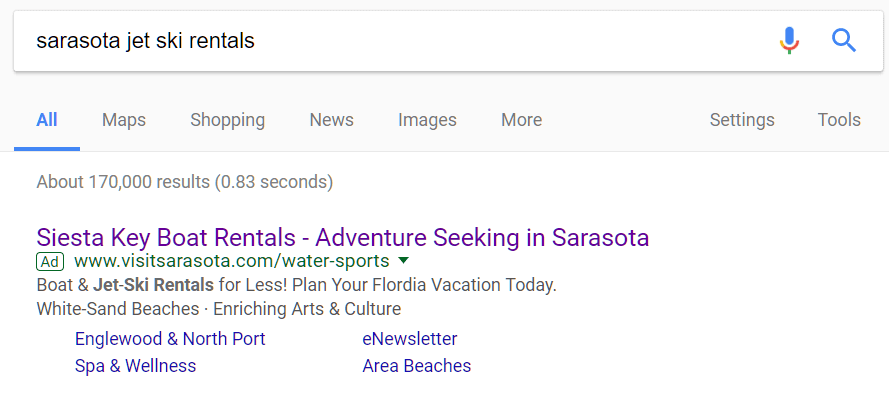
Hey, you’re in town for your wife’s high school reunion, and the warm Gulf of Mexico waters are calling. Why not rent a jet ski and go have some serious fun?
Turns out the top-ranking ad (above), though, is sponsored by the tourist board. The landing page says nothing about jet ski rentals (that can be found in a quick scan), and dampened our guy’s enthusiasm for renting a jet ski in the first place.
Here’s how that page looked above the fold:
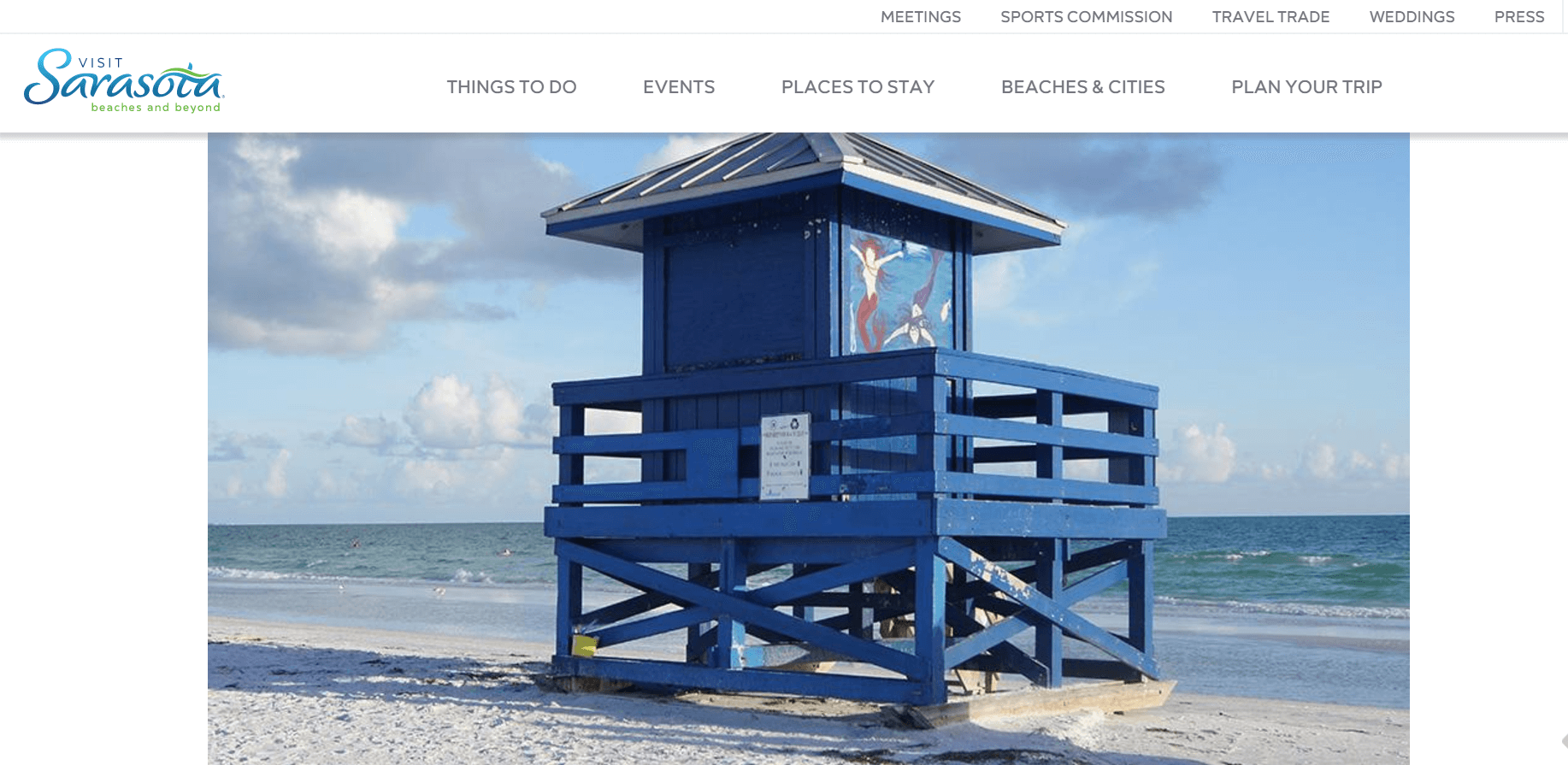
“Surely,” you say, scroll down a little and you’ll find out exactly where to rent that jet ski.”
No dice.
Below the fold, you’ll find general content about water sports on Siesta Key. You’ll also find a real estate ad.
Check it out:
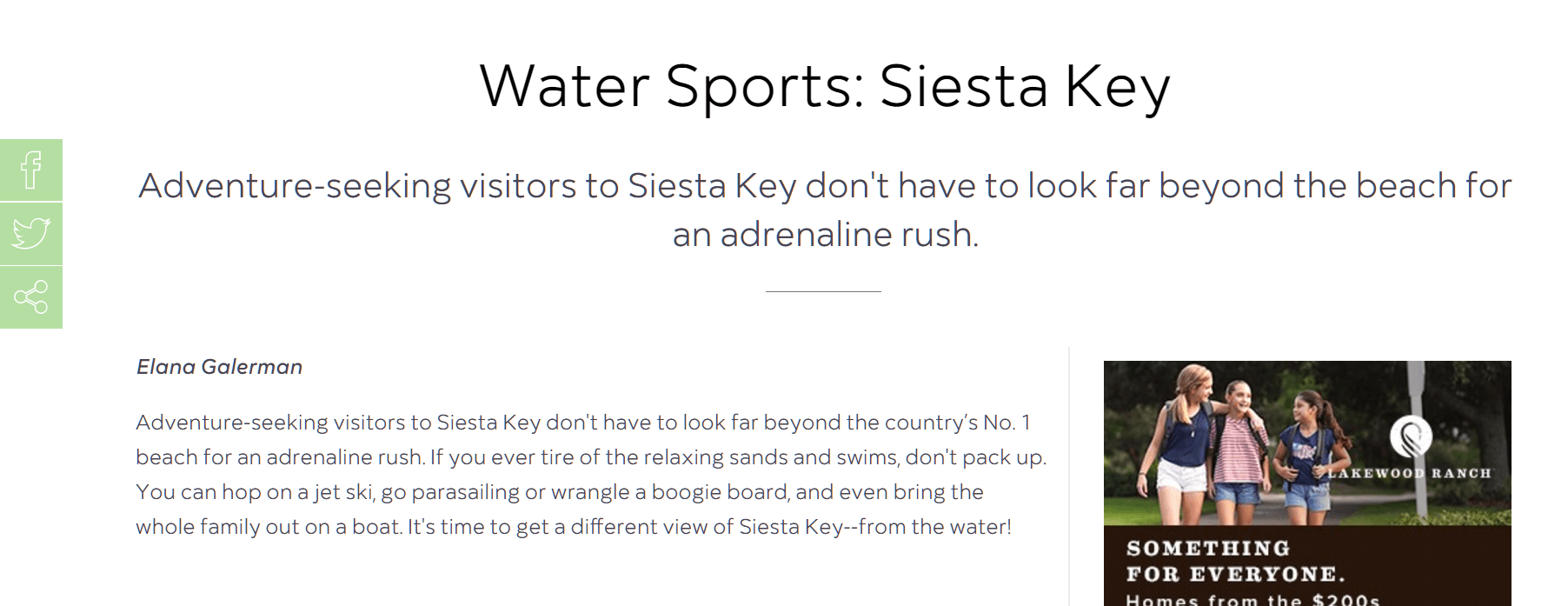
So, what’s your vote?
Will that ad and that landing page combination EVER help someone rent a jet ski? If you’re patient enough and keep scrolling, you’ll find a link to the Siesta Key Watersports home page. And somewhere amidst the parasailing, fishing, dolphin tours, sunset cruises, and fishing charters… you’ll be able to get the info on jet skis you were looking for in the first place.
Let’s look at another example. With jet ski fun on his mind, our writer made hotel arrangements for a soon-coming conference trip to San Diego. He then performed the search shown below:
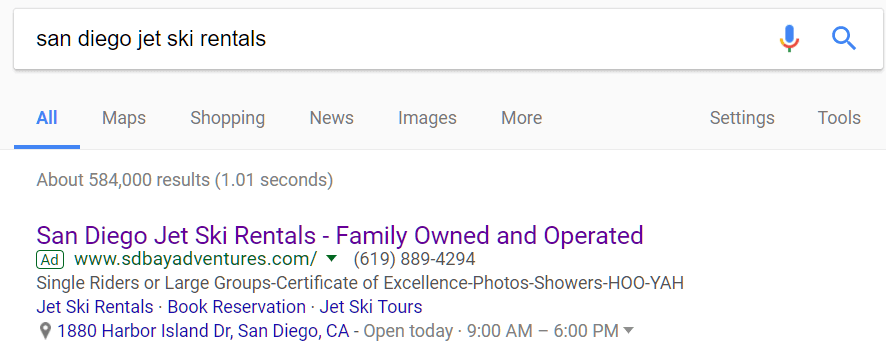
We like this ad (above) better right off. The headline matches the search, and everybody loves a business that’s “Family Owned and Operated.”
SEM has done its job for sure. Our guy was hooked. He didn’t even need the “Certificate of Excellence-Photos-Showers-HOO-YAH” line to seal the deal.
Click.
Search enthusiasm dampened a bit, though, when he saw how slowly the landing page loaded. Per usual, the click took directed him to the home page of the website, not to a special page focused on jet ski rentals.
Slow page load time, by the way, is a major let down. It can be enough to drive clickers away before they become visitors.
Today’s online shopper wants to see a fully loaded page within a few seconds of the click. According to Pingdom, this page takes almost six seconds to load. With a typical hotel-room connection, it’s more like ten.
Why the slow-down? The San Diego Bay Adventures site incorporates a zoom-in photo slider that is colorful and attractive, but exacts a heavy toll on page loading.
Here’s that landing page (home page) above the fold:
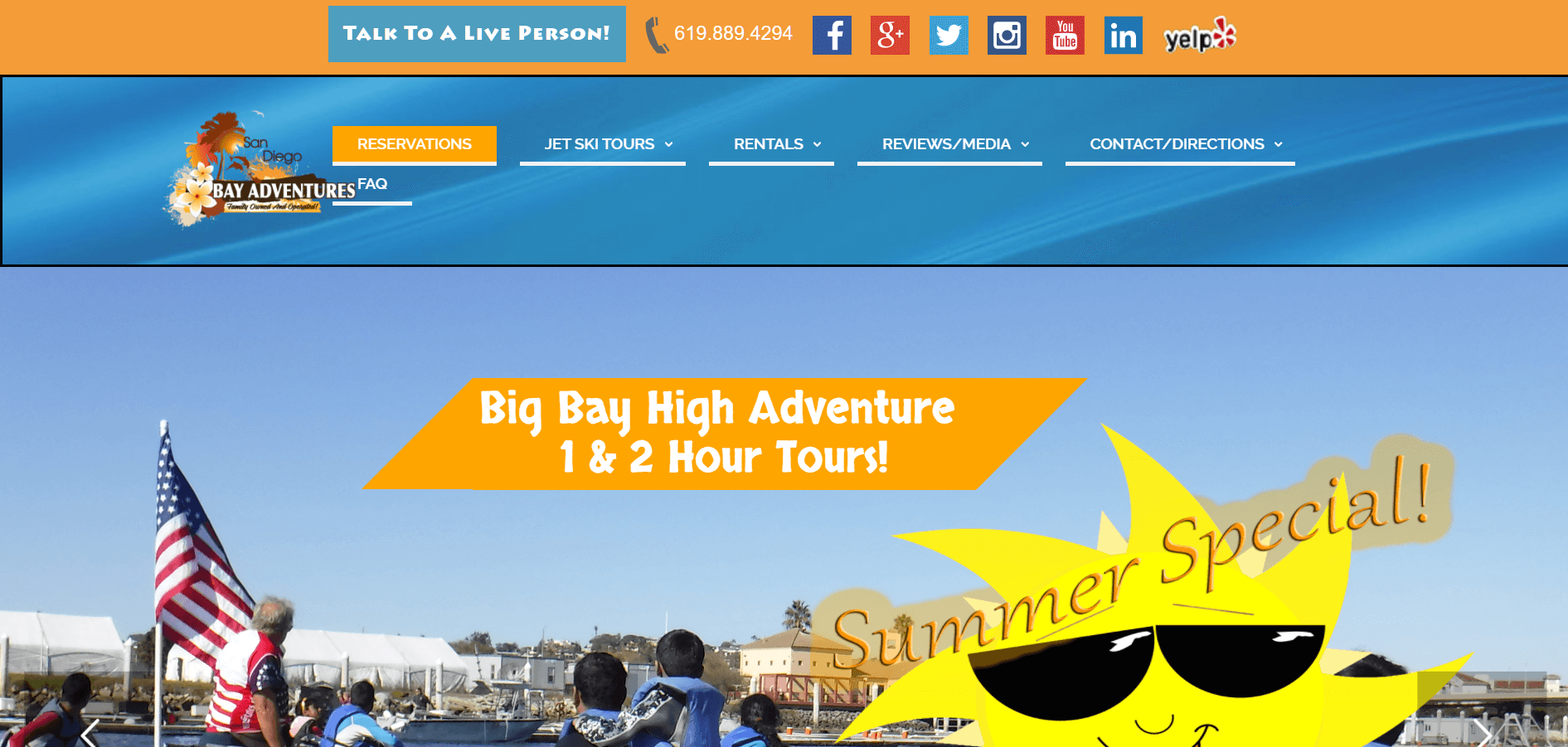
Here again, best practice would be to take the prospect directly to a jet ski rental page – one that loads quickly and provides the info the search seeks.
This one does give a reservation link (in the menu bar) and a jet ski tours link… but once again, it’s disappointing. How hard can it be to rent a jet ski in San Diego?
It takes some scrolling down to find a jet ski rentals button. It’s alongside jet ski tours, paddle boards, and military info.
After the party was over in Sarasota, our guy headed to Disney World in Orlando. He finally hit PPC ad pay dirt… but it wasn’t easy.
Here’s how the SERP looked:
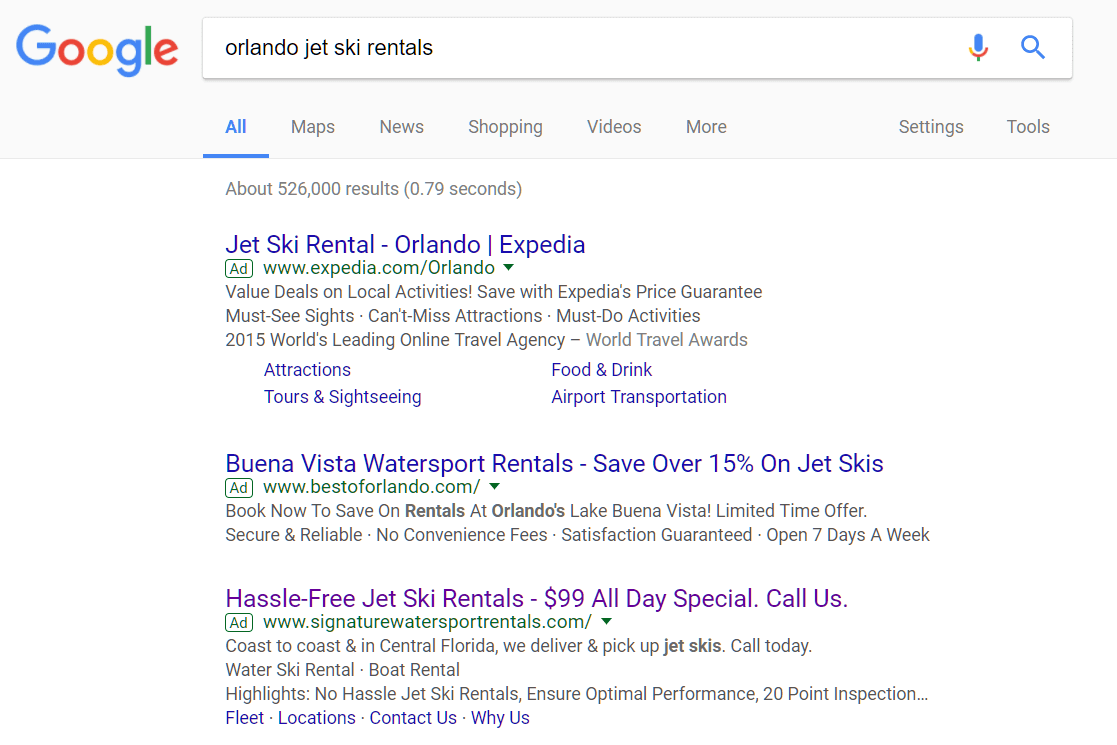
The highest-ranking ad is from Expedia. The second appears to be from another tourist bureau. The third caught our writer’s attention most. Not only does it appear to lead directly to a company that actually rents jet skis, but he liked the idea of that $99 all day special.
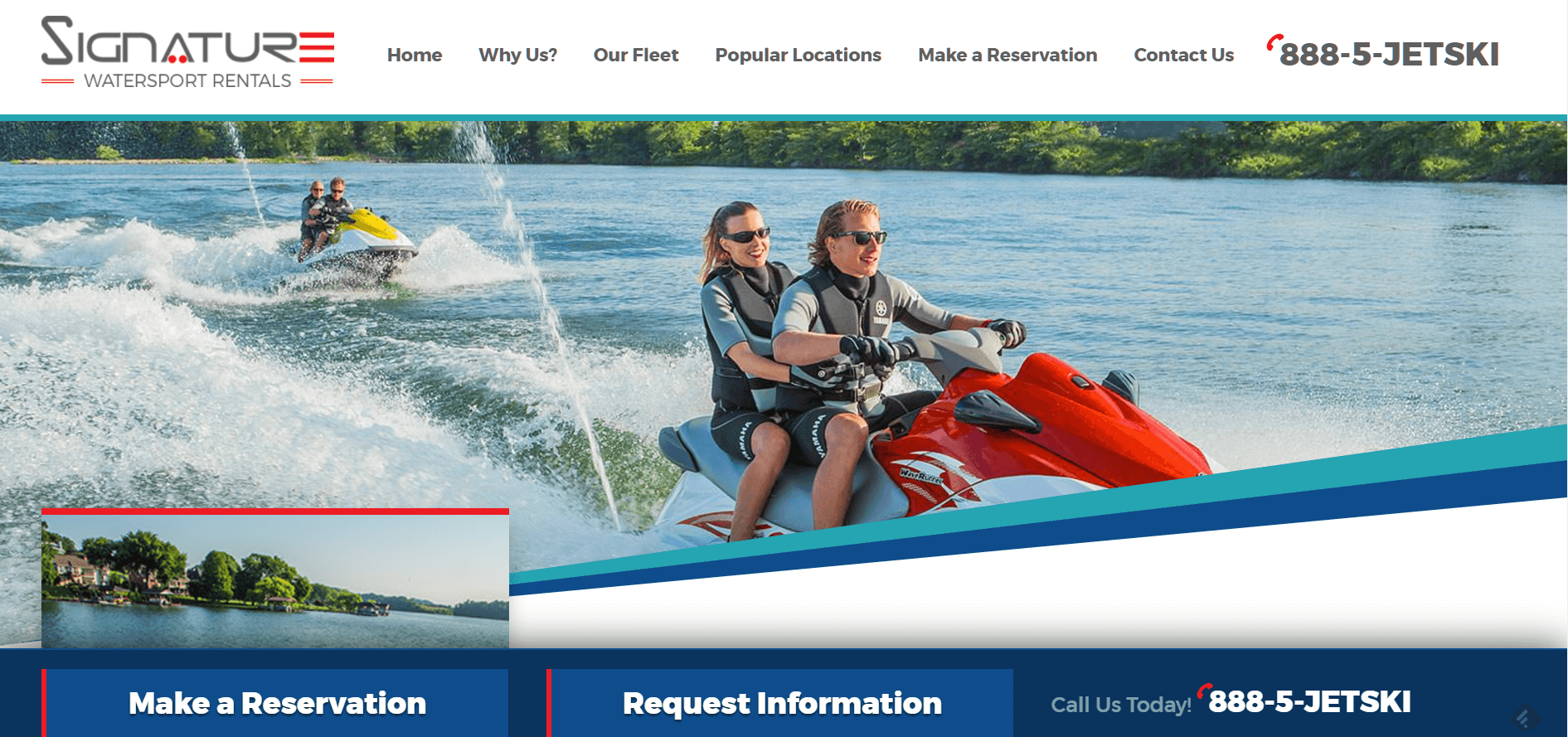
This page loaded in under a second. It’s dedicated to jet ski rental, and it provides everything the visitor needs to make a reservation.
Of the three ads discussed, we’re willing to wager this one converts (for the search term given) much better than the others and delivers a substantial return on investment.
You’ve just seen the ugly, the bad, and the good.
One question remains: why would any advertiser bid on keywords and pay for ads, then fail to send the traffic generated by those ads to a conversion optimized landing page? A page that has been optimized to turn that traffic into sales.
We’re back to the blame game. Advertisers blame the PPC agency for wasting their money, and the PPC management company blames the ecommerce website manager for not providing a suitable landing page.
Remember:
- Traffic without conversions is pointless (and a money pit for client)
- Conversion rate optimization without suitable traffic is pointless (like having a fast car you don’t drive)
SEM and CRO must work together. One without the other is insufficient.
So, what’s the solution?
Here’s How Search Marketing Agencies and Ecommerce Managers Can Help One Another Succeed
Here’s the really crazy thing about this story: both parties to the equation stand to win from a successful ad campaign.
The ecommerce website gets a healthy ROI from the ad spend, and the paid search marketing agency gets commissions PLUS a happy client.
Win-Win.
The missing link is effective conversion rate optimization. SEM agencies typically don’t have the knowledge and experience necessary to produce effective landing pages, and ecommerce managers don’t have the knowledge either.
The unseen need is a third partner. Every stool needs at least three legs in order to stand on its own. Smart companies know that base includes CRO, not just SEM.
> Ecommerce Website Ads + SEM = Frustration
> Ecommerce Website Ads + SEM + CRO = Happy Campers
Our business is CRO, but our aim here isn’t just to beat our own drum. We know from hundreds of cases how the system works. We’ve seen great companies waste money on PPC, and we’ve seen great SEM agencies lose clients because they can’t get a grip on CRO.
And we’ve seen them come to us for the missing link that makes it all come together.
Solving the PPC Agency vs Ecommerce Website Dilemma
Every PPC management service should have a focused CRO partner – not just a digital marketing company that hangs out a shingle for CRO (and really only performs basic A/B testing on thing like button colors).
Paid search marketing requires help from a dedicated CRO with a thorough conversion framework, strategic knowledge, and proven experience.
But, there’s more to the picture. Every ecommerce manager needs CRO help too. When SEM meets ecommerce and nobody on board has the ability to make the CRO connection, financial disasters happen and tempers flare.
Here’s a challenge to SEM managers reading this: we’ve provided three good leads in the case study examples given above.
It’s fairly obvious that Visit Sarasota, Siesta Key Watersports, and San Diego Bay Adventures could use help. A talented SEM manager could step in and help them get more bang for their buck… IF the CRO factor is called out and rectified. Why not contact those companies and help them get more sales at less expense?
Generating traffic without providing a suitable landing page to convert that traffic is like throwing perfect fast balls when nobody is at bat. It’s good exercise, but there won’t be any scores.
Got questions? Just ask. Leave a comment below or get in touch.
For more help, here’s some additional resources:
- How to Make a Landing Page a Rainmaker
- How to Quickly Get Started with Ecommerce Optimization
- Conversion Rate Optimization Essentials: The Master Guide

About the Author
David Hoos
David Hoos is the former Director of Marketing at The Good and a trusted advisor to marketing experts.